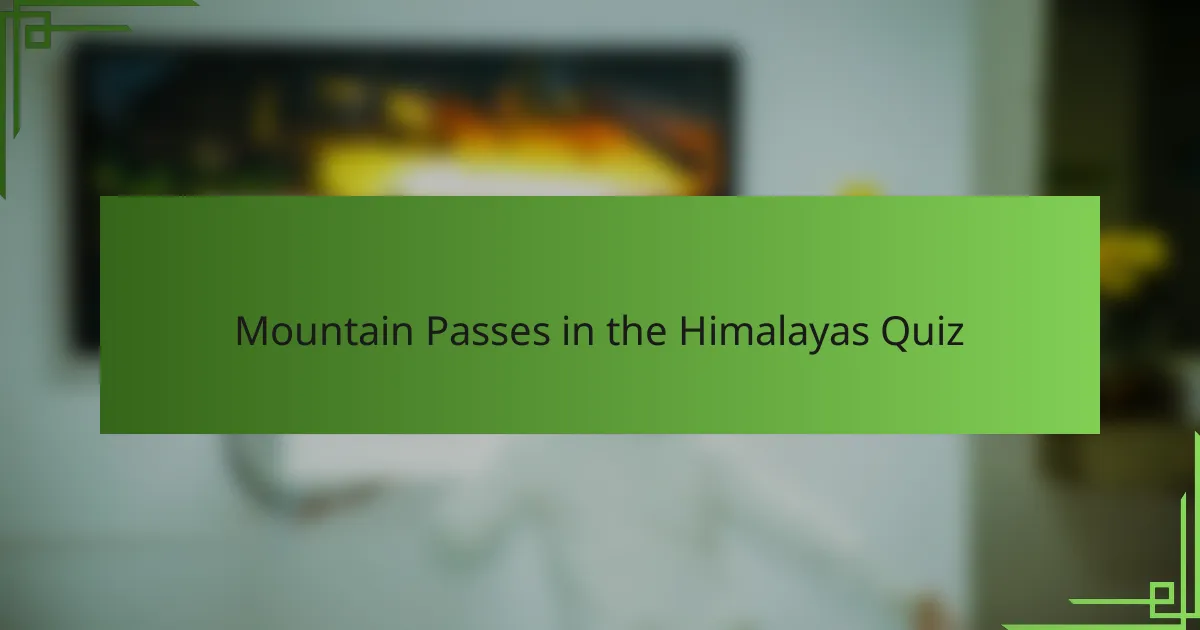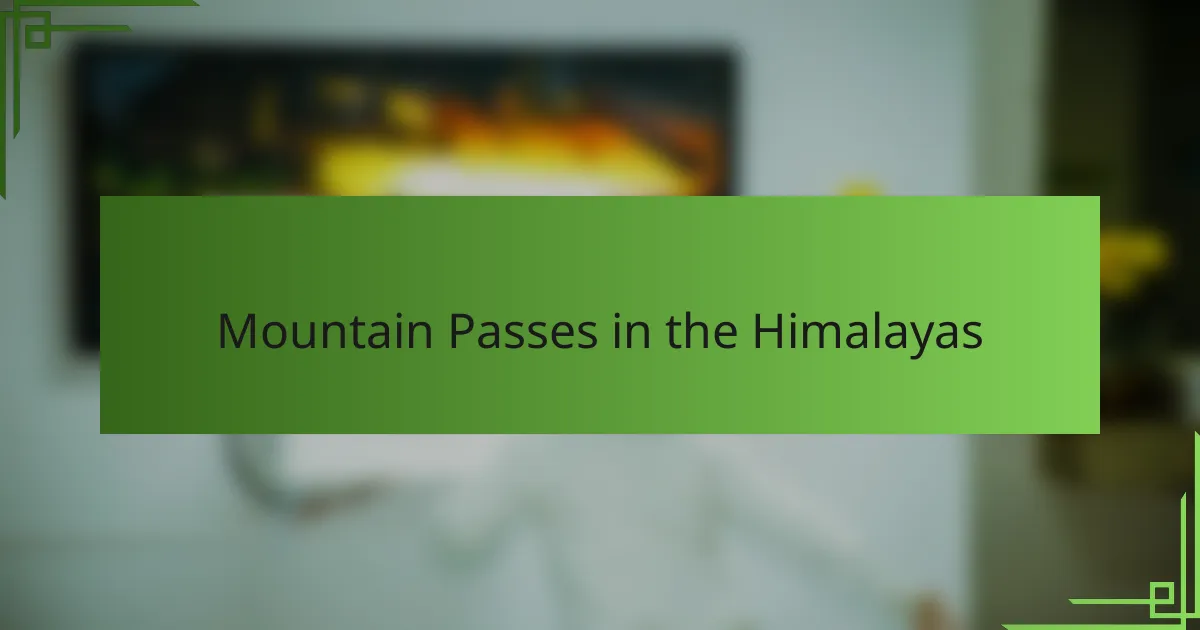
Mountain Passes in the Himalayas Quiz
1. What is the elevation of the Khardung La pass in the Himalayas, often claimed to be one of the highest motorable passes in the world?
- 5,200 meters (17,060 feet)
- 4,980 meters (16,339 feet)
- 5,359 meters (17,582 feet)
- 5,602 meters (18,379 feet)
2. Which mountain pass connects the Indian union territory of Ladakh with the Kashmir Valley?
- Nakee La
- Fotu La
- Khardung La
- Zoji La
3. Nathu La pass holds strategic importance as it connects which two countries in the Himalayas?
- India and China
- India and Pakistan
- India and Nepal
- China and Bhutan
4. Which Himalayan mountain pass serves as a key route between Nepal and Tibet?
- Kodari Pass
- Nathu La Pass
- Thorong La Pass
- Lipulekh Pass
5. At approximately 5,360 meters elevation, which pass is the highest motorable pass in the Indian Himalayas?
- Khardung La
- Baralacha La
- Rohtang La
- Tanglang La
6. Which mountain pass in the Himalayas is known as the gateway to the Spiti Valley?
- Taglang La
- Kunzum Pass
- Baralacha La
- Rohtang Pass
7. The Lipulekh Pass is used traditionally for trade between India and which neighboring country?
- Pakistan
- Nepal
- China
- Bhutan
8. Which mountain pass is crossed by the famous Manali-Leh highway in the Indian Himalayas?
- Rohtang Pass
- Khardung La Pass
- Zoji La Pass
- Baralacha La Pass
9. The Rohtang Pass connects the Kullu Valley with which other valley in the Indian Himalayas?
- Parvati Valley
- Spiti Valley
- Kangra Valley
- Lahaul Valley
10. Which mountain pass is considered the main route for pilgrims heading to Mount Kailash in Tibet?
- Nathu La Pass
- Jelep La Pass
- Zoji La Pass
- Lipu Lekh Pass
11. Zojila Pass connects the Kashmir Valley to which region of Ladakh?
- Zanskar Valley
- Kargil Valley
- Dras Valley
- Nubra Valley
12. Which Himalayan pass is known for its challenging weather conditions and connects Himachal Pradesh to Ladakh?
- Nakee La
- Rohtang Pass
- Kunzum Pass
- Baralacha La
13. Kunzum Pass is located in which Indian Himalayan state and connects Lahaul with Spiti?
- Uttarakhand
- Himachal Pradesh
- Sikkim
- Jammu and Kashmir
14. At which mountain pass does the border meet where India, Nepal, and China converge in the Himalayas?
- Kunzum Pass
- Lipulekh Pass
- Nathu La Pass
- Jelep La Pass
15. Which mountain pass in the Himalayas is traditionally used for the trans-Himalayan salt trade routes?
- Nathu La
- Khardung La
- Rohtang Pass
- Zoji La

Quiz on Mountain Passes in the Himalayas Completed Successfully
Congratulations on completing the quiz! Exploring the mountain passes in the Himalayas offers a unique perspective on geography, highlighting the diverse terrains and natural challenges faced by travelers and locals alike. Through this quiz, you have gained insight into the strategic importance of these passes, their altitude variations, and their role in connecting different regions across one of the world’s most formidable mountain ranges.
Many participants discover fascinating facts about the climate, history, and cultural significance surrounding these passes. You likely learned how these routes influence weather patterns and animal migration, along with their use in ancient trade and modern tourism. Understanding the geography of the Himalayas deepens appreciation for the natural world and the human stories carved into its landscape.
To expand your knowledge even further, we invite you to explore the next section on this page, where detailed information about mountain passes in the Himalayas is presented. This resource covers geographical features, environmental conditions, and their impact on local communities in greater depth. Dive in to enrich your understanding and satisfy your curiosity about these remarkable geographical landmarks.

Mountain Passes in the Himalayas
Geographical Significance of Mountain Passes in the Himalayas
Mountain passes in the Himalayas serve as natural routes through the formidable mountain range. These passes allow for connectivity between distinct valleys and regions separated by towering peaks. They exist at high elevations and often mark the lowest points on mountain ridges. Geographically, they influence local climate patterns by channeling winds and regulating moisture flow. Their strategic positions make them crucial for trade, migration, and military movements in countries like India, Nepal, Bhutan, and Tibet. Notable examples include the Khardung La and Nathu La passes.
Topography and Elevation Characteristics of Himalayan Passes
Himalayan mountain passes exhibit extreme topographical features including steep ascents, narrow trails, and rugged terrain. Elevations of these passes typically range from 4,000 meters to over 5,600 meters above sea level. For instance, the Thorong La pass on the Annapurna Circuit in Nepal reaches about 5,416 meters. Such heights result in thin air, low temperatures, and challenging weather conditions which impact accessibility. The geological composition around these passes includes metamorphic rocks and glacial formations shaped by tectonic activity of the Indian and Eurasian plates.
Khardung La Pass: Geographic and Strategic Overview
Khardung La is one of the highest motorable passes in the world, situated at approximately 5,359 meters in the Ladakh region of India. Geographically, it connects the Leh region to the Shyok and Nubra valleys. This pass lies within the Karakoram Range, part of the greater Himalayas. Khardung La is historically strategic for military logistics due to its proximity to the India-China border. Its elevation and ruggedness require specialized infrastructure to maintain year-round access despite extreme weather.
Nathu La Pass: Geographic Location and Terrain
Nathu La Pass is located at 4,310 meters on the Indo-China border in the Indian state of Sikkim. Its geographical setting lies within the Eastern Himalayas, linking the Indian state of Sikkim with the Tibet Autonomous Region. The pass has a relatively steep and narrow terrain with frequent landslides during monsoon seasons. It is critical geographically for trade and cultural exchanges. The pass reopened for trade and tourism in 2006 after being closed for decades, highlighting its ongoing importance.
Impact of Himalayan Passes on Regional Climates and Ecosystems
Mountain passes in the Himalayas affect local climates by influencing wind patterns and precipitation distribution. They often serve as corridors for moist air masses, causing enhanced rainfall on windward slopes and rain shadows on leeward sides. This creates ecological zones ranging from alpine meadows to temperate forests near passes like the Rohtang La and Zojila. The unique microclimates foster diverse flora and fauna adapted to high altitudes. These ecological impacts are integral to understanding the geographic complexity of the Himalayan region.
What are mountain passes in the Himalayas?
Mountain passes in the Himalayas are natural routes or gaps through the mountain ranges that allow crossing from one valley or side to another. They are typically lower points compared to the surrounding peaks, enabling travel across the rugged terrain. Examples include the Khardung La pass in India and the Thorong La pass in Nepal, renowned for facilitating trade, pilgrimage, and trekking routes.
How are mountain passes in the Himalayas formed?
Mountain passes in the Himalayas form primarily due to tectonic activity and erosion over millions of years. The collision of the Indian and Eurasian tectonic plates created the uplift of the Himalayan range. Erosional forces like glaciers, rivers, and weathering shaped the landscape, carving valleys and lower saddle points which became the passes. For instance, the Thorong La pass was carved by glacial movements in the Annapurna region.
Where are the notable mountain passes located in the Himalayas?
Notable mountain passes in the Himalayas are located across countries such as Nepal, India, Tibet (China), and Bhutan. Prominent passes include Namcha Barwa Pass in Tibet, Nathu La and Lipulekh Passes in India, and the Thorong La and Kang La passes in Nepal. These passes are predominantly found at altitudes exceeding 4,000 meters and serve as critical corridors in the high-altitude Himalayan geography.
When are the mountain passes in the Himalayas typically accessible?
Mountain passes in the Himalayas are generally accessible during the warmer months, from late spring to early autumn (May to October). Accessibility depends on weather conditions and snow levels. For example, the Thorong La pass is commonly trekked between March and November, when snow is minimal. Winter months usually see heavy snowfall, making many passes impassable due to avalanches and extreme cold.
Who uses the mountain passes in the Himalayas?
Mountain passes in the Himalayas are used by local communities, traders, pilgrims, and trekkers. Historically, these passes served as trade routes connecting remote valleys and regions, such as the Silk Road routes through the Karakoram passes. Pilgrims use passes like Lipulekh to reach sacred sites, while modern adventure tourists use passes like Khardung La for trekking and motor expeditions. Local herders and nomads also traverse these passes seasonally.
